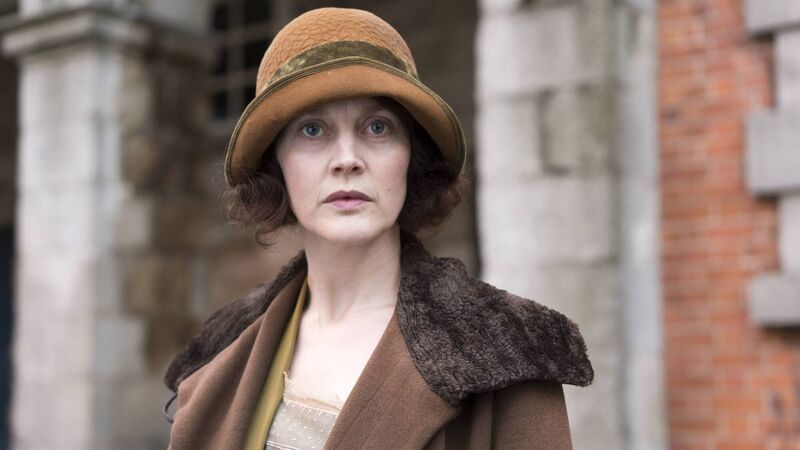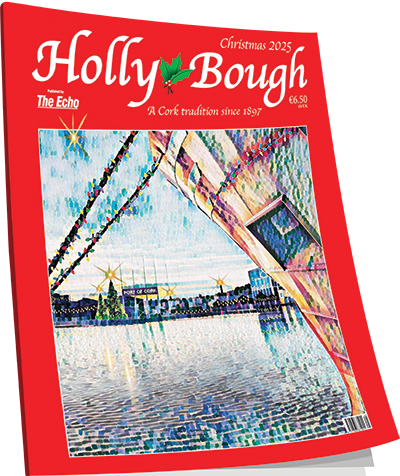TV show adoption plot has Cork roots

AS the centenary of the start of the War of Independence and the formation of the first Dáil looms on Monday, interest in those momentous events of a century ago is mounting.
A new Sunday night RTÉ drama, entitled Resistance, is tapping into the nostalgia.
The five-part series, set during the War of Independence, is a follow-up to the RTÉ drama Rebellion, which was set during the 1916 Easter Rising, and retains several key cast members such as Brian Gleeson, with screenwriter Colin Teevan also on board.
Resistance is a blend of factual events and real historical figures, such as Michael Collins, with fictional storylines.
So when one character, Ursula Sweeney, is shown trading top secret British information so that she can be reunited with her son, many viewers assumed this was a fictional event.
In the drama, Ursula’s son is taken from her by nuns in a convent, and is set to be adopted by a wealthy family in Boston, USA, against her wishes.
The situation is complicated by the fact that Sweeney is a cryptologist and intelligence officer at Dublin Castle. In desperation, she is put in contact with the IRA and told they may be able to get her son back... if she starts feeding them information about the British military based in Dublin Castle.
In the second episode of the six-part drama last Sunday, we saw Ursula, played by Simone Kirby, having a game of poker with her British military bosses — while playing her own high stakes game and giving her new IRA contact Jimmy Mahon — a hitman for Collins — the name of an accountant working for the British.

Kirby says of her role as anguished mum Ursula: “To find herself suddenly in between the IRA and Dublin Castle is not somewhere she really thought she would ever be.”
The actress adds: “In her personal life, she had a tragedy a few years before when her fiance was killed when he went to war. She was pregnant and wasn’t married so she had to give her child up. That’s where we found her in the first episode, she was about to lose her child to an American.
“It’s that weird time in the middle, after the Rising and before the Treaty, where people kind of went underground. There are people like Ursula who didn’t choose to be one side or the other.”
The truly fascinating part of this storyline in Resistance is that it mirrors a real-life mother-and-baby wrangle — which played out right here in Cork and in Collins Barracks. Sometimes, truth really is stranger than fiction...
******
The story of Cork woman Josephine O’Donoghue, who spied for the IRA in Cork on condition that they kidnap her son from her in-laws in the UK, was told in a 2006 book entitled Florence And Josephine O’Donoghue’s War Of Independence, by UCC historian John Borgonovo, published by Irish Academic Press,
It also featured in a TG4 documentary in 2012 entitled In Ainm an Mhic — In the Name of the Son — which also screened at that year’s Cork Film Festival. UCC historians Professor John A. Murphy and Borgonovo himself contributed to the documentary.
In the book, Borgonovo tells how Florence (Florrie) O’Donoghue, intelligence officer of the First Cork Brigade of the IRA, was one of the key figures in the War of Independence.
He arrived in Cork from Rathmore as a 16-year-old to work as an apprentice in a draper’s shop. The 1916 Rising and the execution of its leaders politicised him and he was soon to play an active role in the reorganisation of the Volunteers in the city area.
Appointed brigade intelligence officer, he was responsible for leading a highly-effective intelligence and counter-intelligence organisation that kept the IRA fully aware of British activities and plans.
Part of the reason for O’Donoghue’s great success in this was the fact that he had met Josephine Marchment, a widow of a British Army Officer who worked at Cork’s Victoria (now Collins) Barracks, the heart of British military administration in the south. Florence enlisted Josephine as a spy.
Josephine had lost the custody of her son and O’Donoghue promised to kidnap him from Wales and reunite the two as a reward for her espionage work. Remarkably, their relationship turned into an unlikely romance and Florrie and Josephine eventually married.
The story begins in 1913 when Josephine, the daughter of an RIC officer from Pallaskenry, Co. Limerick, met Welsh Protestant Coleridge Brown. He converted to Catholicism and they wed and had two sons, Gerald and Reggie.

In 1916, Coleridge went off to fight in World War I and his wife moved in with his parents.
However, Josephine was to suffer a series of devastating losses, starting when her mother died in 1914.
Some historians have speculated that she was suffering from depression when she moved to Ballinlough in Cork in late 1916, to look after her recently widowed father.
She brought her baby son Gerald with her, but left her other son, Reggie, with her in-laws. Josephine then got a job as a typist at Victoria Barracks.
She then lost her father and, in October, 1917, her husband was killed in action in the war. It then emerged that Coleridge had written sealed letters requesting that his children be brought up Protestants, and his sister should look after Reggie.
It appears that Coleridge’s family simply refused to hand Reggie over to her. Devastated, the devout Catholic Josephine went for advice to then Bishop of Cork, Daniel Coholan, who advised her to take a custody battle.
She did so, but lost out in the English courts — it’s thought the judge was biased against Catholics.
Paddy Hayes, the man behind the 2012 TG4 documentary on the story, said: “They resorted to putting the four-year-old Reggie on the stand and asking him who he wanted to stay with. Having spent the years of legal wrangling with his grandparents, he was bound to opt for them over a mother he now barely remembered.”
Paddy added that the story of Josephine and her baby “was like a Ripley’s: Believe it Or Not, at first we found it hard to believe there was such an amazing story out there.
“We seriously considered making it a feature film of it, because it blows something like Michael Collins out of the water for me. I’ve never come across a better story.”
At her lowest ebb, a vulnerable Josephine was recruited by O’Donoghue — some say she was put in touch with the IRA by a local priest. The operation was approved by Michael Collins.
O’Donoghue brought Reggie back to Cork himself in December, 1920. Even then, he stayed with Josephine’s sister and she could only meet him in secret for the duration of the War of Independence.
In return, Josephine became one of the most important IRA intelligence sources of the War of Independence.
She remained a vital mole for the IRA until the ceasefire in July, 1921, and managed to evade capture. It is even speculated that her espionage may have led to the deaths of some of her neighbours.
As head of office administration in the barracks, she was in daily contact with senior officers in Cork, including Major Bernard Montgomery, later to become the famous general ‘Monty’ of World War II desert fame.
Thanks to Josephine, many British agents and spies in the city were revealed to the IRA and dealt with accordingly.
The TG4 documentary ended with her wedding to Florrie in SS Peter and Paul’s Church on April 27, 1921, and they went on to have four children — two sons and two daughters — and lived in Loughlene, Douglas Road.
The couple kept the story of Reggie secret for 40 years until they presented their story to their children in 1961. The book by Borgonovo also reveals details of 47 letters written by O’Donoghue to his wife while he was ‘on the run’ during the last ten weeks of the Anglo-Irish War, from May to July, 1921.
******
The inclusion of the Ursula Sweeney storyline in Resistance has been welcomed by many viewers, as it features a female narrative to the War of Independence That is a theme that was brought up in the foreword to Borgonovo’s book in 2006, when Professor Joseph Lee of UCC stated that, while the British were uperior in manpower, the Irish were superior in women power, thanks to the efforts of the likes of Josephine O’Donoghue.
Lee added: “Among the many rewards of this engrossing account is the increased understanding it conveys of the importance of the contribution of ‘ordinary’ women, as well as of the ‘ordinary’ men, to the struggle.”
This story of adventure, intrigue and romance in the life of Florence and Josephine O’Donoghue always deserved to be told to a wider audience.
Now, it has.







 App?
App?





